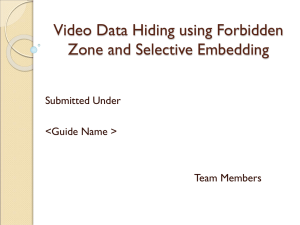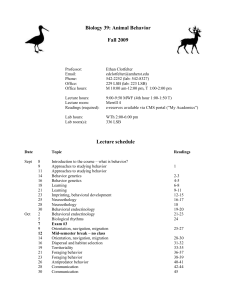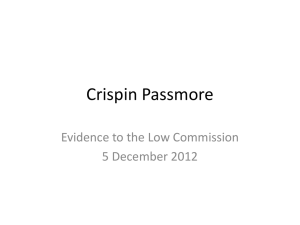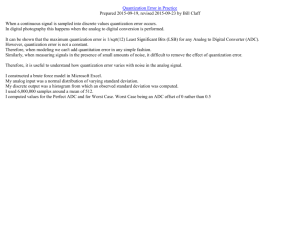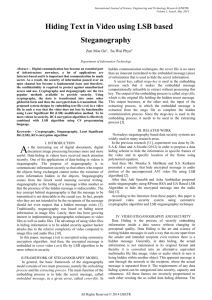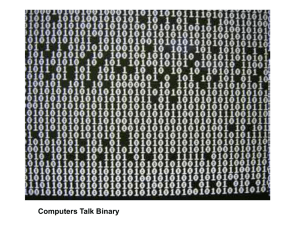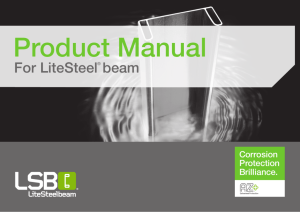Lee - Department of Computer Science
advertisement
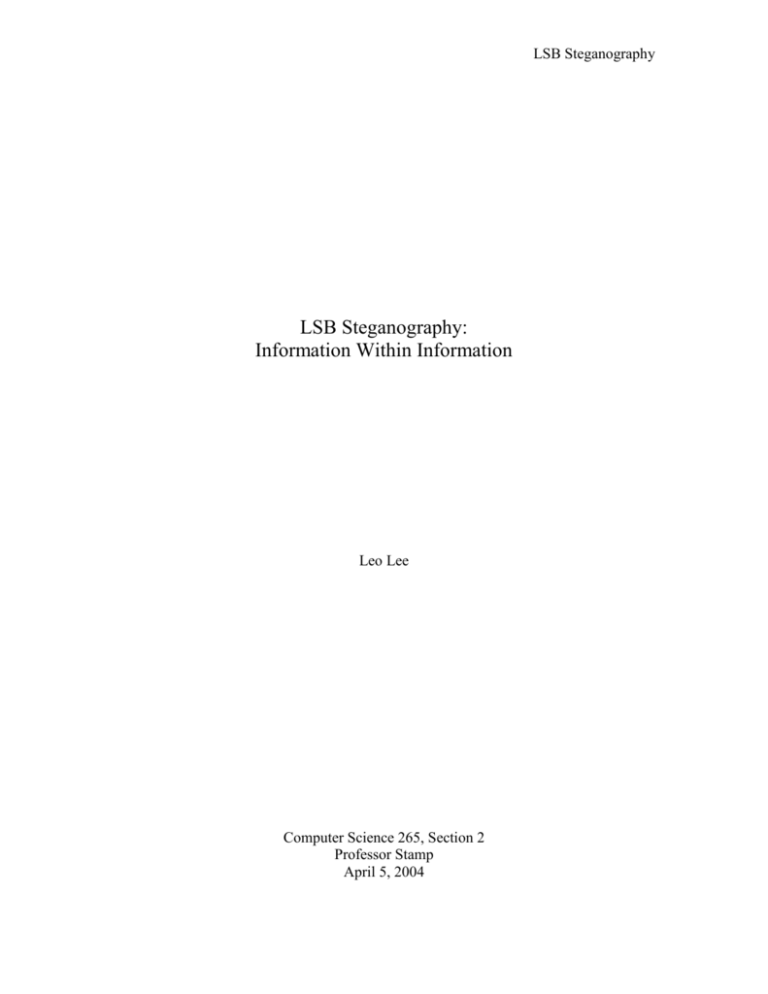
LSB Steganography LSB Steganography: Information Within Information Leo Lee Computer Science 265, Section 2 Professor Stamp April 5, 2004 LSB Steganography Introduction Steganography is the science of hiding secret messages within an otherwise normal, innocent medium. Steganography has long been in use, even before the invention of the computer. For example, warring nations used invisible ink and microdots to communicate messages covertly. However, computer technology has taken steganography to the next level. Nowadays, messages are typically hidden within digital images, video and audio. This paper focuses on one particular popular technique, Least Significant Bit (LSB) Embedding, using digital images as the medium. The terminology is that a message is hidden within a cover image to produce a stego-image. First, the choice of a good cover image is discussed. Then, variations of LSB Embedding are detailed. Finally, the advantages and disadvantages of LSB Embedding are summarized. The Basic Idea of LSB Embedding The concept of LSB Embedding is simple. It exploits the fact that the level of precision in many image formats is far greater than that perceivable by average human vision. Therefore, an altered image with slight variations in its colors will be indistinguishable from the original by a human being, just by looking at it. By using the least significant bits of the pixels’ color data to store the hidden message, the image itself will seem unaltered. Picking a Good Medium As important as the steganographic technique is, equally important is the choice of the cover image. In LSB Embedding, a poor choice of cover image can lead to a stego-image that is easily differentiable from the original. Current image formats can be divided into two broad categories, lossy and lossless (Johnson & Jojodia, 1998). Lossy images are those formats, which loses some of the image’s data when stored. An example would be JPEG. The plus side of lossy images, in particular JPEG, is that it achieves extremely high compression, while maintaining fairly good quality. However, due to the very nature of lossy formats, it is not suitable for LSB Embedding. Since LSB Embedding spreads the hidden message throughout the image’s data, the loss of the image’s data by compression would lead to 1 LSB Steganography the lost of parts of the hidden message. On the other hand, lossless images are suitable for LSB Embedding, since the integrity of the image data is preserved. However, they do not have the high compression ratio that lossy formats do. Not all lossless images are good candidates as a cover image. 24-bit bitmaps, as well as grayscale images and other color images with small variations in its palette are good candidates as cover images. The reasons will be detailed in the respective sections below. The Simple Case – 24-bit Bitmaps Perhaps the simplest implementation of LSB Embedding is that using 24-bit bitmaps. According to the Worldwide Center for the Study of Leif Computer Science Team (2001), the structure of a 24-bit bitmap is a bitmap header, followed by the pixels’ data. Each pixel is represented by three bytes, representing the red, green and blue color values for that pixel. The higher the number, the more intense that color is for that pixel. For example, if the data for a pixel pa were FF FF FF16, that pixel would contain the most of all three primary colors and thus be white. LSB uses the fact that changing the LSB of these bytes would produce only a minute, insignificant change to the color value (Johnson & Jojodia, 1998). For example, changing the color values for pa to FE FE FE16 would make the color darker by a factor of 1/256. This change would be imperceptible to the human eye. The idea then is to simply encode one bit of the hidden message in the LSB of each byte of pixel data. Thus, we can embed <number of bytes per pixel> * <number of pixels in image> bits of secret information in any particular cover image. In the implementation however, one should be aware of a particular detail. In 24bit bitmaps, the number of bytes per row is always end-padded with zeros to be a multiple of four. Although initially one may think to use these extra bytes to store hide additional information that would be unwise. Since these bytes are supposed to contain zeros, any alteration would be easily detectable. Thus, in order for the image to remain inconspicuous, only the LSBs of the actual pixel data should be altered. Listing 1 and 2 contain an implementation of LSB Embedding using 24-bit bitmaps as described. 2 LSB Steganography 8-bit/Grayscale Images Formats such as 8-bit bitmaps use a palette. Instead of storing the pixel’s color value directly, each pixel is represented by an offset into a palette. The palette itself is in the header, and contains all of the color values in that image. In an 8-bit image, there are 256 possible colors in the palette. Johnson and Jojodia (1998) note that LSB Embedding cannot usually be done directly as in the 24-bit case. This is because even a plus or minus one change to the palette offset, could change color value drastically. Neighboring colors in the palette do not necessarily have to be similar. One way around this problem is to simple use only cover images that do contain only similar colors. In fact, many Steganographers advise the use of grayscale images, since it is difficult to discern the various shades of gray from one another. Johnson and Jojodia (1998) presents that the EzStego tool uses this approach. It assumes that the cover image has many similar colors, and tries to rearrange the colors within the palette so as to minimize the change between adjacent colors in the palette. Johnson and Jojodia (1998) present another tool, S-Tools’ approach to this problem. It solves this problem by reducing the 256 colors limitation of the 8-bit bitmap, and using the freed up bits to store the message. It tries to do this in such a way as to preserve the quality of the original cover image. However, degradation will inevitably occur. For example, it can reduce the palette to basically 128 unique colors (7-bits to represent the offset). Then, two similar colors are created for each of these unique colors. This is done by appending the number 02 or 12 to each of the 128 unique colors. Now, for each pixel’s color offset, either of the two similar colors can be used, depending on what the message bit to hide is. In effect, this is using the 24-bit LSB scheme with some preprocessing overhead. This method is superior to that of EzStego, because it allows the use of a wider variety of cover images. However, it has the drawback that the image quality will suffer. Therefore, in this approach a cover image with similar colors is still preferable, since it would make the lost of quality less perceptible. 3 LSB Steganography Other Variations of LSB Variations of the basic LSB technique have been developed in order to make it more robust. So far, the techniques that have been described are called sequential LSB. That is, the message is laid out across the image data sequentially. One variation would be random LSB, in which the secret data are spread out among the image data in a seemingly random manner. This can be achieved if both the sender and receiver share a secret key. They can use this key to generate pseudorandom numbers, which will identify where, and in what order the hidden message is laid out. The advantage of this method is that it incorporates some cryptography in that diffusion is applied to the secret message. However, it goes beyond just making it difficult for an attacker knows that there is a secret message to figure out the message. It also makes it harder to determine that there was a secret message in the first place. The reason is because the randomness makes the embedded message seem more like noise statistically than in the sequential method. Another variation to regular LSB is to repeat the message multiple times across the image data. This way, if the message is relatively small compared to the cover image, the message may survive any image manipulation, such as cropping. However in this case, a redundant pattern may be easier to discern, and will seem less like random noise. Thus the image may be more susceptible to statistical steganalysis. Conclusion – The Ups and Downs of LSB As presented, LSB Embedding has the advantage that it is simple to implement. This is especially true in the 24-bit bitmap case. It also allows for a relatively high payload, carrying one bit of the secret message per byte of pixel data. In addition, it is also seemingly undetectable by the average human if done right. However, the assumption has been that the stego-image is indistinguishable from the original cover image by the human eye. There have been many statistical techniques developed to determine if an image has been subjected to LSB Embedding. For further research see 4 LSB Steganography Chandramouli and Memon (2001), Fridrich, Goljan and Du (2001), and Zhang and Ping (2003). In addition to being vulnerable to detection techniques, LSB is extremely vulnerable to corruption. That is, the integrity of the hidden message can easily be destroyed. All the attacker must do is to randomize the LSBs of the image. The attacker may not even know that it is a stego-image, but such actions would destroy the secret message. Due to these possible attacks, LSB Embedding is relatively insecure, at least in its primitive form. However, due to its advantages, it is useful for applications where security is desired, but not necessary. It is also a good foundation to build more secure steganographic techniques. 5 LSB Steganography References Chandramouli, R. & Memon, N. (2001). Proceedings of ICIP ’01: IEEE International Conference on Image Processing. Thessaloniki: Institute of Electrical and Electronics Engineers Computer Society. Fridrich, J., Goljan, M., & Du, R. (2001). Detecting LSB steganography in color and gray-scale images. IEEE Multimedia, 8(4), 22-28. Johnson, N. F., & Jajodia, S. (1998). Exploring steganography: seeing the unseen. IEEE Computer, 31(2), 26-34. Worldwide Center for the Study of Leif Computer Science Team. (2001). .bmp: Disrobing the bitmap format. Retrieved March 26, 2004, from http://theleif.org/compsci/bitmap.html Zhang, T. & Ping X. (2003). A new approach to reliable detection of LSB steganography in natural images. Signal Processing, 83, 2085-2093. 6

